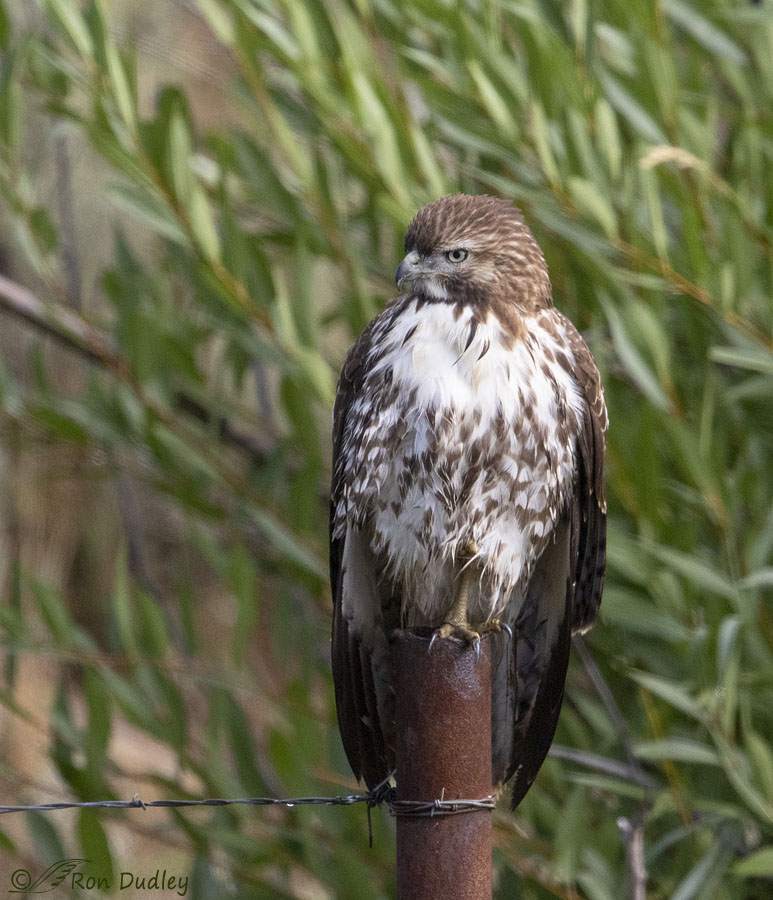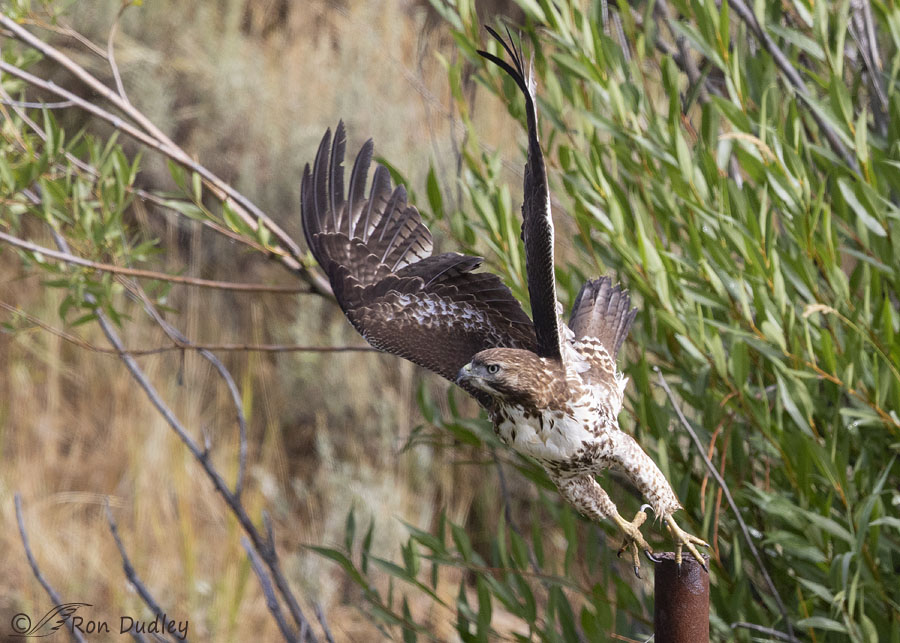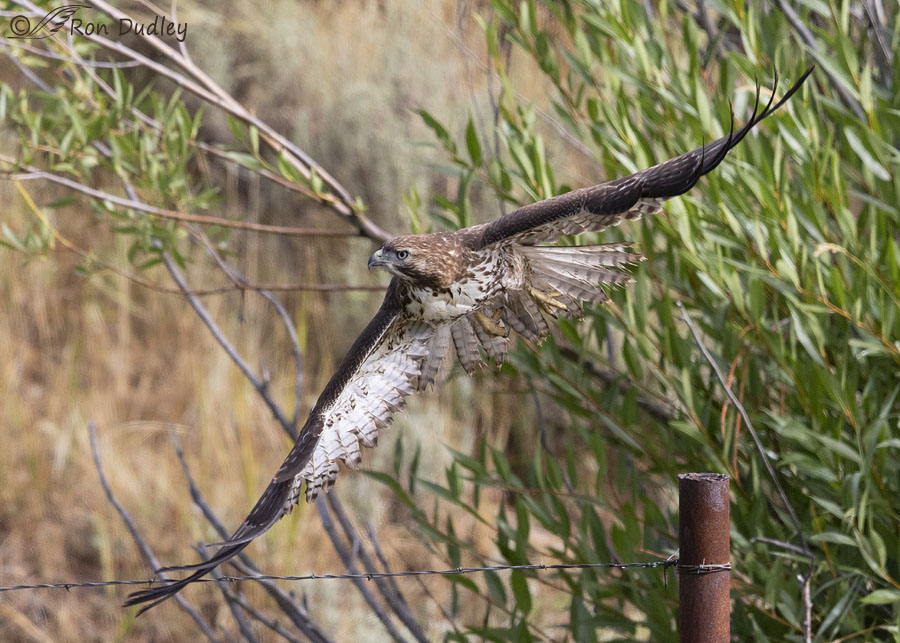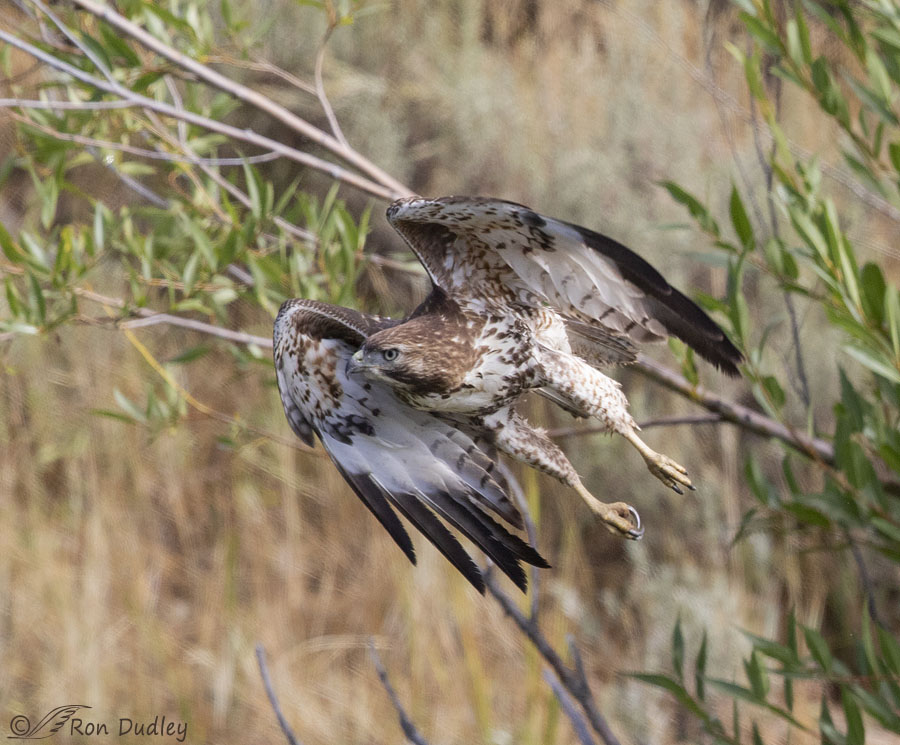Waterlogged or not “he” lifted off just fine.

1/2500, f/6.3, ISO 1600, Canon 7D Mark II, Canon EF 500mm f/4L IS II USM + EF 1.4 III Extender, not baited, set up or called in
You’ve seen this juvenile Red-tailed Hawk before. I photographed him in the mountains just over a week ago and then posted some photos of him as he ate a vole on a different perch and then took off after another presumed vole (which he missed). These photos were taken a little later the same morning after at least two attempts at prey. After chasing after several voles in the long grass that was wet from an earlier rain the hawk was wet too, as evidenced by his obviously wet lower belly and droopy wings.
The lighting was low beneath the overcast skies so I really cranked up my ISO to get more shutter speed. Poor light and high ISO’s are definitely not a recipe for high image quality but I still think these photos turned out reasonably well given the conditions.
After this shot I removed my teleconverter to give me more room in the frame in case he took off. He did.

1/2000, f/6.3, ISO 1250, Canon 7D Mark II, Canon EF 500mm f/4L IS II USM, not baited, set up or called in
I’ll include three consecutive photos taken during takeoff and just after. The leaning branch behind him and to the left was a bother in all three of them because I think it’s a little distracting but I was happy to get him sharp in all three in this low light.
One thing I often notice when birds, raptors in particular, take off is how they use their tails for additional lift. With their wings raised and just prior to leaving the perch their tail is raised and not flared but…

1/2500, f/6.3, ISO 1250, Canon 7D Mark II, Canon EF 500mm f/4L IS II USM, not baited, set up or called in
as their wings come down they flare their tail and bring it down quickly too, providing additional lift above and beyond that provided by the wings. Buteos are large and relatively heavy birds so every bit of lift helps, especially at that critical moment. I imagine it helps with their body angle in flight also.
1/2000, f/6.3, ISO 1250, Canon 7D Mark II, Canon EF 500mm f/4L IS II USM, not baited, set up or called in
In this last shot I didn’t have much room on the left for composition purposes so the bird is nearly centered in the frame. I think the effort, strain and concentration required for liftoff is well illustrated in this photo.
Most photos of buteos I’ve taken and posted this past summer have been of red-tails because Swainson’s Hawks have been scarce but I’m hoping it will be a good winter for Rough-legged Hawks to make up for it.
I’ve seen reports that they’re already headed my way.
Ron



Ron,
I kinda like the leaning limb, especially in the last photo. It lines up nicely with the general leaning of the bird. Gives the whole photo a unified look.
BTW, I went to Farmington Bay this morning. Holy Cow, guns, boats, pick-ups and camo. The hunt is on!!
I tried out my new mirrorless Nikon Z7… Sweet!
Best,
Stephen
Ha, it’s the Youth Hunt out there today, Stephen. I made the mistake of going once, never again.
I am blown away by flight. And love, love, love seeing ‘close-ups’ of the athleticism and precision required. Thank you for sharing this majestic and marvellous bird. It does look a tad peeved in the first shot, but so would I if I had failed to get all my breakfast.
“so would I if I had failed to get all my breakfast”
And you were wet and cold to boot? Recipe for pissedofftedness…
Of course. And I love pissedofftedness. I describes me more often than I like to admit.
I’ll have to watch for that tail action and see if I can catch it in “real time”. Hope to see you post some RLH’s this winter. Does your new truck have heated seats?
Lyle, it isn’t new (5 years old now) and no, it doesn’t have heated seats. Sometimes I wish it did.
I don’t see that “tail action” so much when they take off from elevated perches such as power poles.
Sorry, must have confused the truck and trailer. I’ll have to put it on my signs of dementia list, if I can find it.
Ron, your description of the hawk’s movements on take-off were quite interesting. Interesting enough that I went to Cornell to find out their wingspan is 44.9″-52.4″ and the biggest females weigh in at about 3 lbs. Quite a balancing act they have. Love all of your photos of such a beautiful bird. Thank you, Ron
And 3 lbs. is pretty darned heavy for a bird. Depending on conditions (wind, elevated perch or not etc.) becoming airborne often isn’t an easy task for them. Thanks, Alice.
I just love take off shots–the mechanics of flight just make me smile. I’ve often imagined the sheer confidence it takes to just open your wings, jump off a high place and just not go SPLAT on the ground!! Seriously, what a cool thing to be able to do! Have you ever held a feather (a molted feather of course) and tested it’s strength, flapping it (as best a human can) in the wind? They’re such an amazing blend of fragile and incredibly strong. Birds just fascinate me (along with the rest of you) and I love these slices of time that show how they do what they do.
As usual, fantastic shots!! Thank you!
Yes, I’ve done that with feathers, Laura. It’s interesting to do it in a moving car by holding it out the window and watching how it reacts to the wind at different angles and speeds.
Thanks for your notes on the physiological mechanics of the “lift off”—-it takes a lot of careful observation to pick up on such details, and I appreciate learning about them !
And I appreciate knowing that you learned from them, Kris. Takeoff happens so quickly that before I began to photograph birds I couldn’t appreciate the timing of events that gets them airborne during takeoff.
Great take off shots Ron. And he had his head turned perfectly for a beautiful catch-eye and kept it that way throughout the takeoff. Capt Sullenberger in his Airbus A320 could not have had a more perfect takeoff.
Sully would be proud of that bird. Thanks, Everett.
More fantastic raptor photographs to enjoy as I sip strong coffee! Great way to start any day. Thank you!
I know we all hate random trees, twigs, branches in the background, but in this case you managed to find some pointing/leaning in the same direction as the hawk is heading. The angle of the bird’s body complements the angle of the branches. Very clever of you.
That look in the first image is simply B.V. (“Before Vole”). Same look I have “Before Coffee”.
“Very clever of you”
Yup, I had that all planned out, Wally!
Superb series Ron!
Charlotte
Thanks, Charlotte.
As you realize,Ron, manmade objects such as fenceposts detract from nature shots in the eyes of some folks.
Of course I do. I’ve made that point dozens of times on my blog.
Most birds are NOT happy when wet unless bathing……. Hungry and wet probably did have him annoyed! Beautiful shots regardless of the technical difficulties….
Hungry and wet probably did have him annoyed! Beautiful shots regardless of the technical difficulties….  The tail action for take off is interesting – as you noted every little bit of lift helps… We’re doing off/on rain tho mostly just enough to wet the ground and mess up the winter wheat planting for awhile that’s underway in this area. Glad I don’t live in SE TX right now!
The tail action for take off is interesting – as you noted every little bit of lift helps… We’re doing off/on rain tho mostly just enough to wet the ground and mess up the winter wheat planting for awhile that’s underway in this area. Glad I don’t live in SE TX right now!
“Glad I don’t live in SE TX right now”
It’s all relative, isn’t it Judy. We’ve been fairly wet recently too, wet for us anyway. But absolutely nothing like Texas.
Beautiful series! I agree with Marty, he/she looks upset in the first shot, but his/her persistence will pay off I’m sure.
I need to get out more with my medium lens. VBG!
Thanks, Dick. Even with my tc removed I was still shooting at an effective 800mm.
Fabulous shots! He looks sorta pissed in the first shot — perhaps too many near misses. Wonderful takeoff pose in the second shot. You caught the intense curve of the leading edge of those wings (yay Bernoulli!) in the third shot. And 11/10 degree of difficulty in the last shot!
And there’s your play-by-play (or shot-by-shot) commentary for the morning. Dang! I need to get more sleep.

If he was mad in that first shot it’s probably because he was wet and had nothing to show for it. Thanks, Marty.
Thanks, Marty.